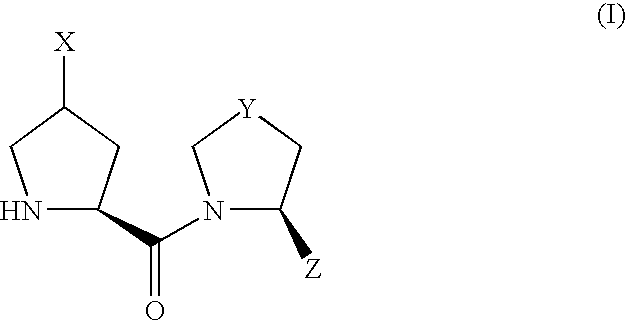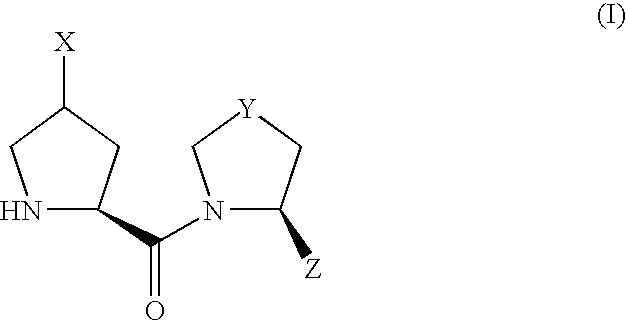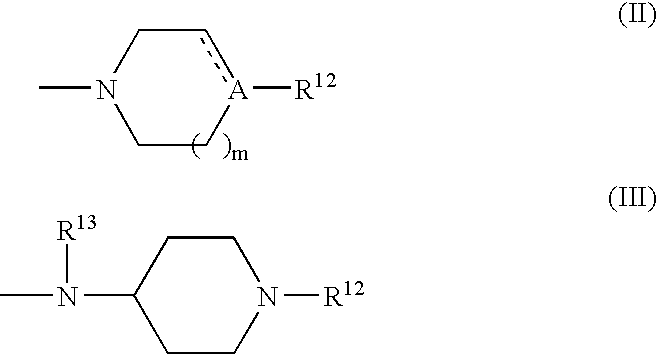Proline derivatives and use thereof as drugs
a technology of proline and derivatives, applied in the field of proline derivatives, can solve the problems of unsatisfactory pharmaceutical products, and achieve the effects of sufficient inhibitory activity, sufficient stability and safety, and potent dpp-iv inhibitory activity
- Summary
- Abstract
- Description
- Claims
- Application Information
AI Technical Summary
Benefits of technology
Problems solved by technology
Method used
Image
Examples
reference example 1
Synthesis of (S)-1-((2S,4S)-1-tert-butoxycarbonyl-4-hydroxy-2-pyrrolidinylcarbonyl)-2-cyanopyrrolidine
[0147](1) N-tert-Butoxycarbonyl-L-cis-4-hydroxyproline (23.1 g) and imidazole (30.0 g) were dissolved in DMF (300 mL). tert-Butyldimethylsilyl chloride (33.3 g) was added thereto. After stirring at room temperature for 16 hr, water (300 mL) was gradually added under ice-cooling. The reaction solution was acidified with 10% aqueous citric acid solution and extracted with ethyl acetate. The extract was washed 3 times with water and with brine, and dried. The solvent was distilled away under reduced pressure. The residue was purified by silica gel chromatography to give N-tert-butoxycarbonyl-L-cis-4-tert-butyldimethylsilyloxyproline (27.4 g) as a white solid.
[0148](2) The above-mentioned compound (27.4 g) and (S)-2-cyanopyrrolidine hydrochloride (10.4 g) were dissolved in DMF (250 mL), and triethylamine (10.9 mL), HOBT (14.3 g) and EDC hydrochloride (18.0 g) were added successively. Th...
reference example 2
Synthesis of (S)-1-((2S,4R)-1-tert-butoxycarbonyl-4-hydroxy-2-pyrrolidinylcarbonyl)-2-cyanopyrrolidine
[0151]N-tert-Butoxycarbonyl-L-trans-4-hydroxyproline (68.4 g) and (S)-2-cyanopyrrolidine hydrochloride (39.2 g) were dissolved in DMF (350 mL), and triethylamine (41.4 mL), HOBT (49.9 g), and EDC hydrochloride (62.5 g) were successively added. The mixture was stirred at room temperature for 15 hr. The reaction mixture was concentrated and brine and saturated aqueous sodium hydrogencarbonate solution were added to the residue. The precipitated crystals were collected by filtration. The filtrate was extracted with ethyl acetate and the extract was dried. The solvent was evaporated under reduced pressure. The residue and the crystals were combined and washed with ethyl acetate to give the title compound (60.7 g) as a white solid.
[0152]1H-NMR(CDCl3)δ1.30–1.45(9H, m), 1.54–2.38(5H, m), 3.30–3.93(5H, m), 4.49–4.89(3H, m).
reference example 3
Synthesis of (S)-1-((2S,4S)-4-amino-1-tert-butoxycarbonyl-2-pyrrolidinylcarbonyl)-2-cyanopyrrolidine
[0153](1) (S)-1-((2S,4R)-1-tert-Butoxycarbonyl-4-hydroxy-2-pyrrolidinylcarbonyl)-2-cyanopyrrolidine (title compound of Reference Example 2, 60.7 g) and triethylamine (30.1 mL) were dissolved in DMF (300 mL). Methanesulfonyl chloride (16 mL) was added thereto under ice-cooling. After stirring at room temperature for 3 hr, the reaction mixture was washed with water and dried. The solvent was evaporated under reduced pressure. Ethanol was added to the residue to give (S)-1-((2S,4R)-1-tert-butoxycarbonyl-4-methanesulfonyloxy-2-pyrrolidinylcarbonyl)-2-cyanopyrrolidine (64.1 g) as a white solid.
[0154](2) The above-mentioned compound (64.1 g) and sodium azide (11.8 g) were dissolved in DMF (250 mL), and the mixture was stirred at 85° C. for 5 hr. The reaction mixture was added to water and the precipitated crystals were collected by filtration to give (S)-1-((2S,4S)-4-azido-1-tert-butoxycarb...
PUM
| Property | Measurement | Unit |
|---|---|---|
| temperature | aaaaa | aaaaa |
| temperature | aaaaa | aaaaa |
| temperature | aaaaa | aaaaa |
Abstract
Description
Claims
Application Information
 Login to View More
Login to View More - R&D
- Intellectual Property
- Life Sciences
- Materials
- Tech Scout
- Unparalleled Data Quality
- Higher Quality Content
- 60% Fewer Hallucinations
Browse by: Latest US Patents, China's latest patents, Technical Efficacy Thesaurus, Application Domain, Technology Topic, Popular Technical Reports.
© 2025 PatSnap. All rights reserved.Legal|Privacy policy|Modern Slavery Act Transparency Statement|Sitemap|About US| Contact US: help@patsnap.com



